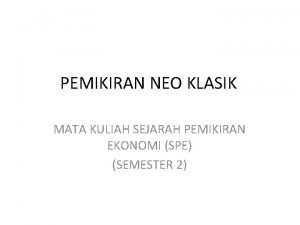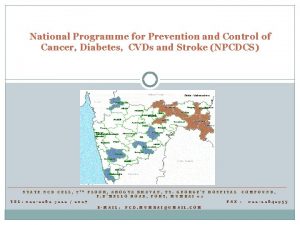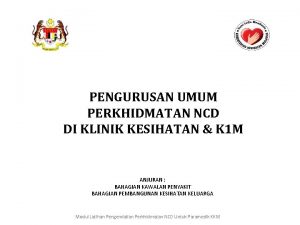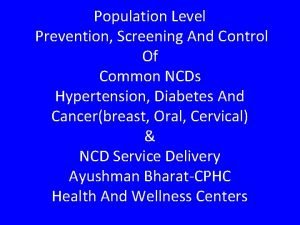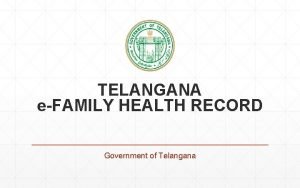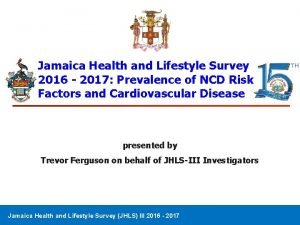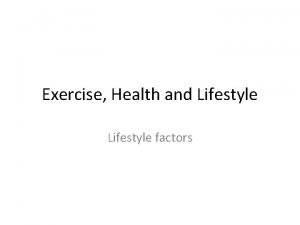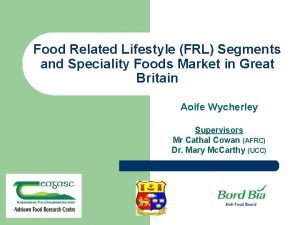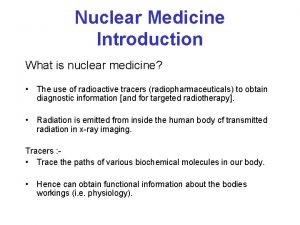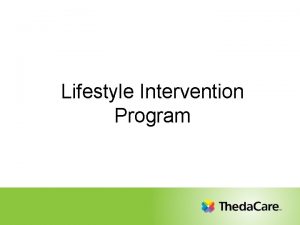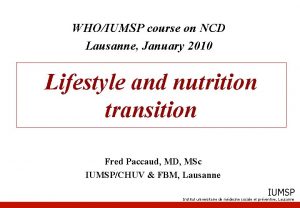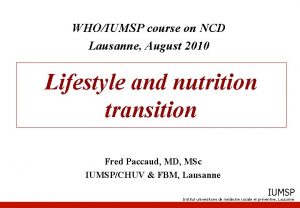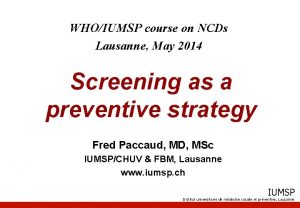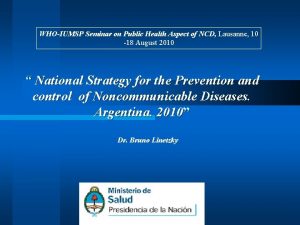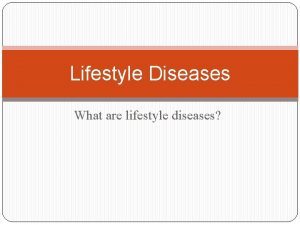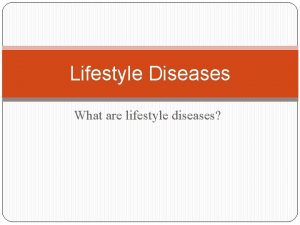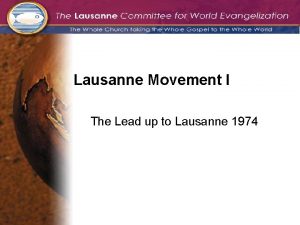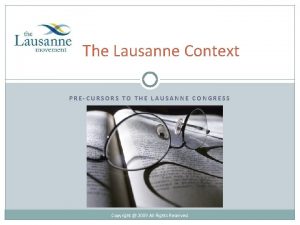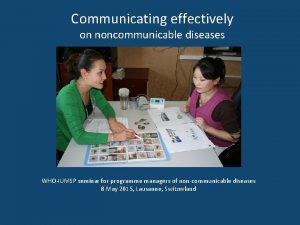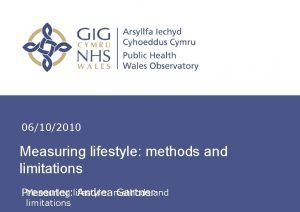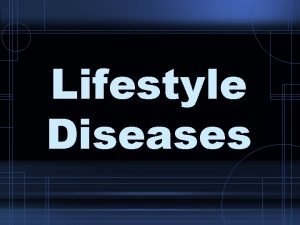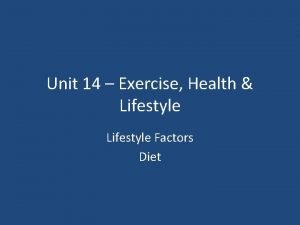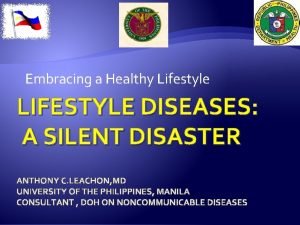WHOIUMSP course on NCD Lausanne March 2011 Lifestyle































- Slides: 31

WHO/IUMSP course on NCD Lausanne, March 2011 Lifestyle and preventive strategies Fred Paccaud, MD, MSc IUMSP/CHUV & FBM, Lausanne IUMSP Institut universitaire de médecine sociale et préventive, Lausanne

Plan § Definitions and characteristics of lifestyles § Tools and strategies to change lifestyles § Individualisation of risk § Population absolute risk vs. relative risk IUMSP Institut universitaire de médecine sociale et préventive, Lausanne 2

Bibilography § Rose G. The strategy of preventive medicine. n Oxford: § Oxford University Press, 1992 Proceedings of The Bellagio Conference on the Nutrition Transition and it's Implications for Health in the Developing World. August 20 -24, 2001. Bellagio, Italy. Public Health Nutrition: 2002 Feb; 5(1 A): 93 -280. IUMSP Institut universitaire de médecine sociale et préventive, Lausanne 3

Lifestyle : Definitions and characteristics (i) § pattern of individual practices and personal behaviours § § that can be related to elevated or reduced health risk this pattern is influenced by personal characteristics (personality makeup, genetic, childhood determinants), and also by a structural context (physical, cultural, socioeconomic environment) as determinants of health, the main characteristic of lifestyles is that they can be changed by decisions taken by an individual … even if this personal decision can be promoted by environmental incentives IUMSP Institut universitaire de médecine sociale et préventive, Lausanne 4

Lifestyle : Definitions and characteristics (i) § Since the 1960 s, growing recognition of the significant contribution of personal behavior choices to health risk § in the US (1990), 38% of deaths attributable to tobacco, diet, physical activity and alcohol § There are four lifestyles which are relevant for public health for chronic diseases (SNAPs) § Tobacco § Diet (including alcohol) § Physical activity § Sexual habits IUMSP Institut universitaire de médecine sociale et préventive, Lausanne 5

Definitions and characteristics (iv) In any population, all lifestyles are likely to change, and most will do so rapidly IUMSP Institut universitaire de médecine sociale et préventive, Lausanne 6

Definitions and characteristics (ii) Tooth brushing IUMSP Institut universitaire de médecine sociale et préventive, Lausanne 7

Plan § Definitions and characteristics of lifestyles § Tools and strategies to change lifestyles § Individualisation of risk § Population absolute risk vs. relative risk IUMSP Institut universitaire de médecine sociale et préventive, Lausanne 8

Tools for changing lifestyle § Lifestyles of individuals are the consequence § cognition, environment and genetic Current public health strategies are focussed on the two first determinants § NB : changing individual lifestyles does influence the environment (cf. Bandura’s theory on social cognitive theory) § Smoking § Physical exercise IUMSP Institut universitaire de médecine sociale et préventive, Lausanne 9

Tools for changing lifestyle (ii) § The three groups of factors influencing lifestyle are: § predisposing factors § attitudes, values, beliefs, perception of needs (cf. “Health belief model”, “Model of stages of changes”, etc. ) § enabling factors § conditions of the environment that facilitate or impede the performance of a predisposition or motivated action by individuals or groups § reinforcing factors § consequences that determines whether the actor receives positive or negative feedback, is supported socially or financially (denormalizing smoking, individual councelling, etc. ) IUMSP Institut universitaire de médecine sociale et préventive, Lausanne 10

Tools for changing lifestyle (iii) § The three groups of public health strategies used to change lifestyle are: § Health education: inform the public (addictive drugs, automobile restraints, maternal alcohol consumption, etc. ) § Health protection: minimize individual decisions through environmental control (milk pasteurisation, fluoridation, etc. ) § Coercion: formal sanction to control individual behaviour (required immunization, drug prohibition, etc. IUMSP Institut universitaire de médecine sociale et préventive, Lausanne 11

Tools for changing lifestyle (iv) § Successful interventions … §… intervene simultaneously on predisposing, enabling and reinforcing factors §… use a combination of education, protection and coercion § Examples: tobacco, hiv IUMSP Institut universitaire de médecine sociale et préventive, Lausanne 12

Tobacco control Action on … education protection coercion predisposing factors Inform about toxicity of tobacco Limit subsidization of tobacco crops Limit tobacco advertising enabling factors Warning messages on tobacco products Increase tobacco Limit access to taxes tobacco products reinforcing factors Enhance the status of the non -smoker Prohibit smoking in public places IUMSP Institut universitaire de médecine sociale et préventive, Lausanne 13

Tobacco control Action on … education protection coercion predisposing factors Inform about toxicity of tobacco Limit subsidization of tobacco crops Limit tobacco advertising enabling factors Warning messages on tobacco products Increase tobacco Limit access to taxes tobacco products reinforcing factors Enhance the status of the non -smoker Prohibit smoking in public places IUMSP Institut universitaire de médecine sociale et préventive, Lausanne 14

IUMSP Institut universitaire de médecine sociale et préventive, Lausanne 15

Poland "Camel. He grew up to be kind. " June 24, 2000 IUMSP Institut universitaire de médecine sociale et préventive, Lausanne 16

Kiss a non-smoker Enjoy the difference IUMSP Institut universitaire de médecine sociale et préventive, Lausanne 17

Plan § Definitions and characteristics of lifestyles § Tools and strategies to change lifestyles § Individualisation of risk § Population absolute risk vs. relative risk IUMSP Institut universitaire de médecine sociale et préventive, Lausanne 18

Epidemiology and individualisation of risk § « the old public health was concerned with the environment; the new is concerned with the individual. The old sought the sources of infectious disease in the surroundings of man; the new finds them in man himself» § Hilbert Hill. The New Public Health. Minneapolis: Journal-Lancet Press, 1913: 10 IUMSP Institut universitaire de médecine sociale et préventive, Lausanne 19

Epidemiology and individualisation of risk § individualisation of risk corresponds to individualisation of prévention, with a shift from populationnal epidemiology to cinical epidemiology and to clinical prevention § Scores of clinical prevention § Lifestyle as a target for prevention IUMSP Institut universitaire de médecine sociale et préventive, Lausanne 20

IUMSP Institut universitaire de médecine sociale et préventive, Lausanne 21

Epidemiology and individualisation of risk § Preventive strategies addressed to degenerative diseases is challenged by two separate problems: (i) Small individual risk : the benefit is almost imperceptible for the single person (ii) long interval between the risk taking and the (potential) completion of the consequences of the risk IUMSP Institut universitaire de médecine sociale et préventive, Lausanne 22

IUMSP Institut universitaire de médecine sociale et préventive, Lausanne 23

IUMSP Institut universitaire de médecine sociale et préventive, Lausanne 24

Risk and vih § risk (= probability) of vih transmission during a sexual intercourse with an occasional partner (C) depends from (i) the prévalence of vih infection (P) and (ii) the risk of transmission during 1 sexual intercourse (c) §C=P*c § Without a condom: P = 0. 01 and c = 0. 01 (say), thus § § § C=0. 0001 or 1/10000 With condom, c=0, and C=0 : the condom abolishes the risk For the single person the difference between 1/10’ 000 and zero is imperceptible For the community, one infection is prevented for every 10’ 000ème rapport occasionnel IUMSP Institut universitaire de médecine sociale et préventive, Lausanne 25

Plan § Definitions and characteristics of lifestyles § Tools and strategies to change lifestyles § Individualisation of risk § Population absolute risk vs. relative risk IUMSP Institut universitaire de médecine sociale et préventive, Lausanne 26

IUMSP 27 Institut universitaire de médecine sociale et préventive, Lausanne 27

Population absolute risk § Predicted effects in various countries of 5 mm. Hg § § reduction in mean systolic BP on deaths and years of life lost (YLL) per 100 000 person-years from CVD Potential absolute benefits are positively associated with current levels of absolute mortality risk: predicted CVD deaths averted in the highest risk populations (Romania, Bulgaria) were over five times higher than in the lowest risk populations (Spain, France) Potential benefits are only weakly related to existing levels of the risk factor of interest IUMSP 28 Institut universitaire de médecine sociale et préventive, Lausanne 28

Predicted deaths from all vascular causes at ages 30– 69 occurring in 2002 that would have been averted by sustained reductions of 5 mm. Hg in mean systolic blood pressures. Eur J Public Health 2010; 20: 103 IUMSP Institut universitaire de médecine sociale et préventive, Lausanne 29

Population absolute risk § High-risk populations should give the highest priority to § § achieving favourable shifts in all modifiable risk factors Favourable shifts in two or more major risk factors will have substantially larger benefits—in a multiplicative way—in populations with larger absolute risk even if each risk is small This argument extend to other populations with varying levels of absolute risk: lower socio-economic strata, for example, stand to gain much more from risk factor reductions than more favoured strata with lower absolute risks IUMSP 30 Institut universitaire de médecine sociale et préventive, Lausanne 30

Plan § Definitions and characteristics of lifestyles § Tools and strategies to change lifestyles § Individualisation of risk § Population absolute risk vs. relative risk IUMSP Institut universitaire de médecine sociale et préventive, Lausanne 31
 March march dabrowski
March march dabrowski March 25 2011
March 25 2011 Pharmacie gamma lausanne laboratoire
Pharmacie gamma lausanne laboratoire Einkaufsstrasse lausanne
Einkaufsstrasse lausanne Cloud integrated storage
Cloud integrated storage Sovereignty is not given, it is taken
Sovereignty is not given, it is taken Martin odersky epfl
Martin odersky epfl Mazhab lausanne
Mazhab lausanne T junction english bond
T junction english bond Course title and course number
Course title and course number Course interne course externe
Course interne course externe Ncd.nhp.gov.in
Ncd.nhp.gov.in Schoology ncd
Schoology ncd Hwc daily reporting portal
Hwc daily reporting portal Hwc.portal
Hwc.portal Ncd center dh amravati address
Ncd center dh amravati address Ncd
Ncd Ncd klinik kesihatan
Ncd klinik kesihatan Ncd anm login
Ncd anm login Jhs.telangana.gov.in
Jhs.telangana.gov.in Jamaica health and lifestyle survey
Jamaica health and lifestyle survey Exercise health and lifestyle
Exercise health and lifestyle Industrial revolution positive and negative effects
Industrial revolution positive and negative effects Life acrostic
Life acrostic Active lifestyle definition
Active lifestyle definition Healthy lifestyle moodboard
Healthy lifestyle moodboard Making wellness a lifestyle
Making wellness a lifestyle Food related lifestyle model
Food related lifestyle model Global fashion logistics
Global fashion logistics Lifestyle medicine
Lifestyle medicine Thedacare lifestyle intervention program
Thedacare lifestyle intervention program Lecture on healthy lifestyle
Lecture on healthy lifestyle







